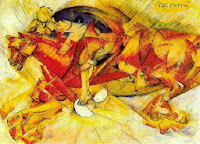Between World War I and II, another art movement developed in Europe, which is the Surrealism. The principles and roots of the Surrealism grew from the Dada movement, an anti-art movement that formed before World War I but expressed in a positive way. In 1924, Andre Breton a major spokesman of the Surrealism published "The Surrealist Manifesto". Surrealism art is a link between the unconscious an concious mind where dreams and fantasy meet the everyday's reality however Breton believes the unconscious mind as the key to imagination. Famous painters such as Salvador Dali, Rene Magritte, Max Ernst amongst others emphasised on the content of free form and gave a new alternative to contemporary art.
One of the most famous artists in Surrealism is Salvador Dali, born on the 11th of May 1904 in Figueras,Spain. Dali was not just a painter, but a sculptor, graphic artist and designer.His mature artistic style was developed mostly when Sigmund Freud erotic writings had subconscious imagery with a significant and when he joined the Surrealists movement after going through the phases of Cubism, Futurism and Metaphysical paintings. In 1929, Dali joined the Surrealists movement, between those years (1929-1937) he produced extraordinary surrealist paintings. Dali followed a process which he himself called it the paranoiac critical, were brought up his hallucinatory states to bring up the images for his paintings. The paintings Dali drew, described them as "hand-painted dream photographs" and depicted strangely hallucinatory characters. His visit to Italy in 1937 was influenced by the Renaissance, mainly by the painter Raphael. Dali adapted that style for his paintings and due to that, Andre Breton expelled him from the Surrealists movement. During 1940 till 1955, Dali moved to the USA and there he spent his time designing fashionable shops, jewellery, theatre sets, interiors and exhibited his eccentricity that made him famous in this movement. Between the 1950 and 1970, his paintings had religious themes, erotic subjects representing his childhood memories and other themes using his wife, Gala.Apart from painting he produced two films, Un Chien Andalou (1929) and L'Age D'Or ( 1930) , with Spanish director Luis Buuel, they featured grostesque but suggestive images. Salvador Dali was one of the most famous artist of the 20th century.
The Persistance of Memory-Time
 | |
The Persistence of Memory, 1931, oil on canvas
One of the most famous paintings in art history and in the Surrealist movement is 'The Persistence of Memory' by Salvador Dali which was produced in 1931 and it was exhibited first at Julien Levy Gallery in 1932 until 1934, were afterwards was moved at the Museum of Modern Art in New York till present. This painting may have different interpretations, but the main theme is time and dreams. The clocks are representing the passing of time as we experience the dreams in our sleep. When we are sleeping or in our subconscious mind, time is irrelevant but we hold on to memories. When asked about the significance of the melting clocks, Dali replied that it was a Surrealist perception of Camembert cheese melting in the sun and represents an unconscious symbol of space and time.Only one clock isn't melted which is the orange clock with ants at a centre point representing the anxiety time brings on us. We humans are always anxious about time some examples are that we are late for work, not accomplish a task or goal in our lives before we die, deadlines given at work or school and many more.The ants thoug
h are found in many of Dali's paintings and they symbolise decay, due to time everything decays and dies and we are always against time. In the middle of the composition there is a creature, which is an abstract self-portrait of Dali and it appeared in other paintings. The creature has one-eye opened and suggests that it is dreaming or decaying after a long time gasping the air. The objects are placed within a sunlit landscape inspired from his homeland Catalonia. To sum it up this painting is a representation of time, death, birth, reality and sexual desires
Nicolas Pioch,2002.WebMuseum:Surrealism.[online] Available at:<http://www.ibiblio.org/wm/paint/glo/surrealism/> [Accessed 27 October 2013] VirtualDali,2013.VirtualDali:Biography.[online] Available at: <http://www.virtualdali.com/ > [Accessed 27 Ovtober 2013] WebMuseum,1997.Salvador Dali Biography.[online] Available at: <https://web.duke.edu/lit132/dalibio.html> [Accessed 27 October 2013] Authentic Society,2006-2011. The Persistance of Memory (Meaning) by Salvador Dali.[online] Available at: < http://www.authenticsociety.com/about/ThePersistenceOfMemory_Dali> [Accessed 27 October 2013] |























